Spotify Technology Bundle
How Does Spotify Dominate the Music Streaming World?
Spotify's annual 'Wrapped' campaign isn't just a recap; it's a cultural event, demonstrating the power of data-driven marketing. Founded in 2006, Spotify transformed from a music streaming service into a user ritual, leveraging a freemium model to combat piracy and build a massive user base. This Spotify Technology SWOT Analysis delves into the strategies that have propelled Spotify to the forefront of the industry.
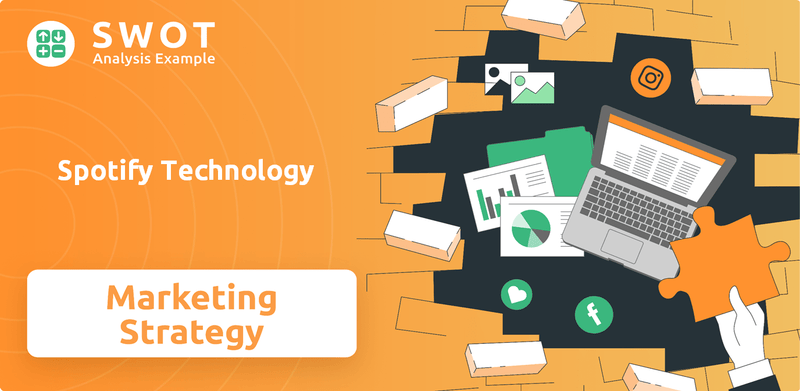
This exploration of Spotify's sales and marketing strategy will dissect its innovative approaches to user acquisition and customer retention, examining its competitive landscape and the effectiveness of its business model. We'll analyze how Spotify uses its data-driven marketing approach, including its social media marketing tactics and content licensing agreements, to maintain its dominance and explore its future growth prospects. Understanding Spotify's sales strategy and marketing strategy is key to grasping its success.
How Does Spotify Technology Reach Its Customers?
Understanding the sales channels employed by Spotify is crucial for grasping its business model and market strategy. The company primarily utilizes a direct-to-consumer (DTC) approach, focusing on its official website and mobile applications as the main avenues for sales. This strategy allows for direct interaction with customers, providing control over the user experience, which is key to Spotify's approach to user acquisition and retention.
The freemium model is a core component of Spotify's sales strategy, functioning as a powerful user acquisition tool. By offering free, ad-supported access, Spotify attracts a large user base, with the aim of converting them into paying Premium subscribers. This model has been instrumental in driving Spotify's impressive growth, as seen in its subscriber numbers.
In Q4 2024, Spotify's global Premium Subscriber base grew to 263 million, an 11% year-over-year increase. This growth continued into Q1 2025, with an additional 5 million net subscribers, bringing the total to 268 million. This demonstrates the effectiveness of the freemium model and the company's ability to convert free users into paying customers. For more in-depth information on the company's financial structure, you can explore Owners & Shareholders of Spotify Technology.
Spotify's primary sales channels are its official website and mobile applications, enabling direct engagement with users. This DTC model allows for control over the user experience and facilitates user acquisition. The freemium model is a key component, converting free users into paying Premium subscribers.
Spotify expands its reach through strategic partnerships, such as collaborations with Google and Opera. These partnerships enhance visibility and offer incentives for subscription. These integrations make Spotify accessible across various ecosystems, contributing to user acquisition and sales growth.
The ad-supported tier serves as a funnel for potential premium conversions. Spotify's automated sales channels significantly contribute to advertising revenue, which saw a 7% year-over-year increase in Q4 2024. This revenue stream supports the freemium model and enhances overall financial performance.
Spotify's growth is measured by its increasing subscriber base and advertising revenue. The company's focus on user acquisition and retention, combined with strategic partnerships, supports its sales growth strategies. The company's market analysis indicates a strong position in the competitive landscape.
Spotify's sales and marketing strategies are centered around a direct-to-consumer model, leveraging its platform and partnerships for user acquisition and revenue growth. The freemium model is a key tactic, converting free users into paying subscribers. The company's data-driven marketing approach and user engagement strategies contribute to customer retention.
- Freemium Model: Offering free, ad-supported access to attract a broad user base.
- Partnerships: Collaborating with companies like Google and Opera to expand reach.
- Advertising Revenue: Utilizing the ad-supported tier to generate revenue and convert users.
- Data-Driven Marketing: Employing data to understand user behavior and personalize marketing efforts.
Spotify Technology SWOT Analysis
- Complete SWOT Breakdown
- Fully Customizable
- Editable in Excel & Word
- Professional Formatting
- Investor-Ready Format
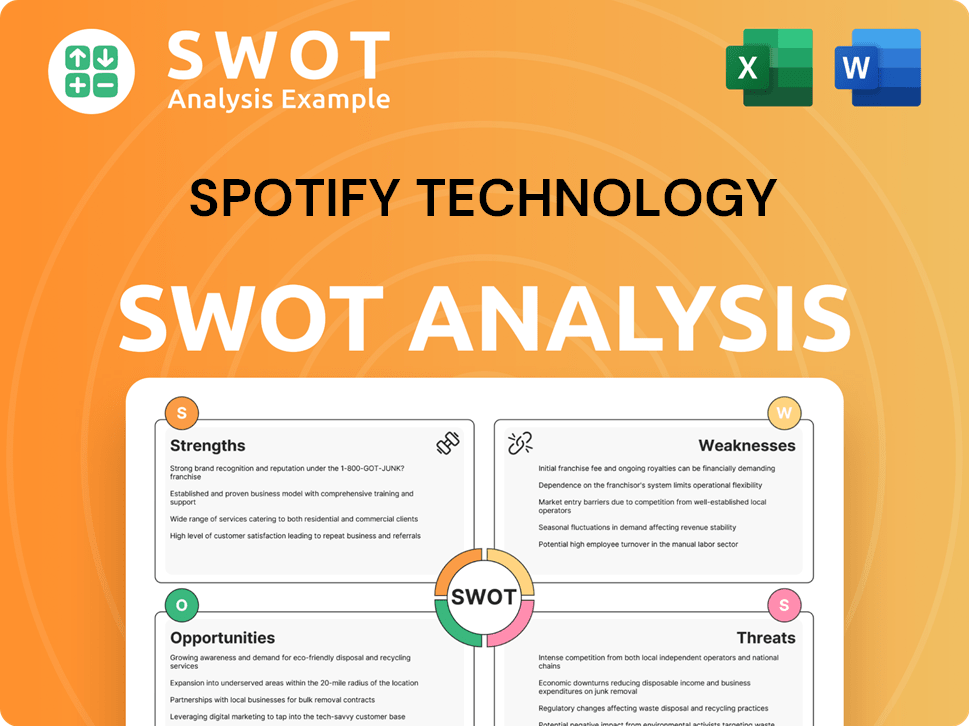
What Marketing Tactics Does Spotify Technology Use?
The success of Spotify's sales and marketing strategy hinges on a multifaceted approach that leverages data, content, and digital channels. By understanding user preferences and behaviors, the platform personalizes the listening experience and tailors its marketing messages. This strategy drives user engagement and fosters loyalty.
A key element of Spotify's marketing strategy is its focus on digital tactics. The company utilizes content marketing, social media engagement, and paid advertising to reach and interact with its audience. Furthermore, strategic partnerships with artists and influencers amplify brand visibility, contributing to user acquisition and retention.
Spotify's marketing tactics are dynamic, adapting to market trends and user feedback. The company consistently invests in innovative features and advertising strategies. This approach ensures its continued relevance and growth in the competitive streaming market, as highlighted in the Growth Strategy of Spotify Technology.
Spotify's 'Discover Weekly' and 'Release Radar' playlists are prime examples of data-driven personalization. These features use machine learning algorithms to curate content based on user listening habits. This approach enhances user engagement and drives customer retention.
With over 100 million tracks and 6.5 million podcasts, content marketing is central. Spotify invests in original podcasts and exclusive deals with creators. Partnerships with artists and influencers amplify brand visibility and appeal.
Spotify actively engages with its audience on platforms like Instagram, TikTok, X/Twitter, and Facebook. The company creates shareable content and encourages user-generated content. This strategy fosters a sense of community and boosts brand visibility.
Paid advertising is a crucial component of Spotify's marketing mix. Advertising revenue is projected to reach $2.1 billion in 2024, a 13% year-over-year increase. It is expected to grow to $2.6 billion by 2026.
Spotify is investing in AI offerings, such as the AI DJ feature, to enhance user engagement. Programmatic advertising is also growing, with programmatic buys increasing by nearly 58% year-over-year in 2024. This strategy improves advertising efficiency and targeting.
Email marketing is used to nurture leads and retain subscribers. Spotify is exploring generative AI tools like 'Quick Audio' to assist brands in creating voiceovers and scripts for advertising. This approach enhances marketing efficiency.
In Q4 2024, Spotify's marketing spend was €393 million, down from €432 million in Q4 2023, reflecting a 9% decrease in marketing investment for the full year 2024. Despite this, the company saw continued user growth, demonstrating the effectiveness of its marketing strategies. The company focuses on a data-driven marketing approach, leveraging user data to tailor content and advertising.
- Spotify's marketing campaigns analysis reveals a strong emphasis on personalization and digital channels.
- Spotify user acquisition is driven by a combination of content, partnerships, and targeted advertising.
- Spotify's sales growth strategies include both premium subscriptions and advertising revenue.
- Spotify's customer retention strategies rely on personalized content recommendations and engaging features.
Spotify Technology PESTLE Analysis
- Covers All 6 PESTLE Categories
- No Research Needed – Save Hours of Work
- Built by Experts, Trusted by Consultants
- Instant Download, Ready to Use
- 100% Editable, Fully Customizable
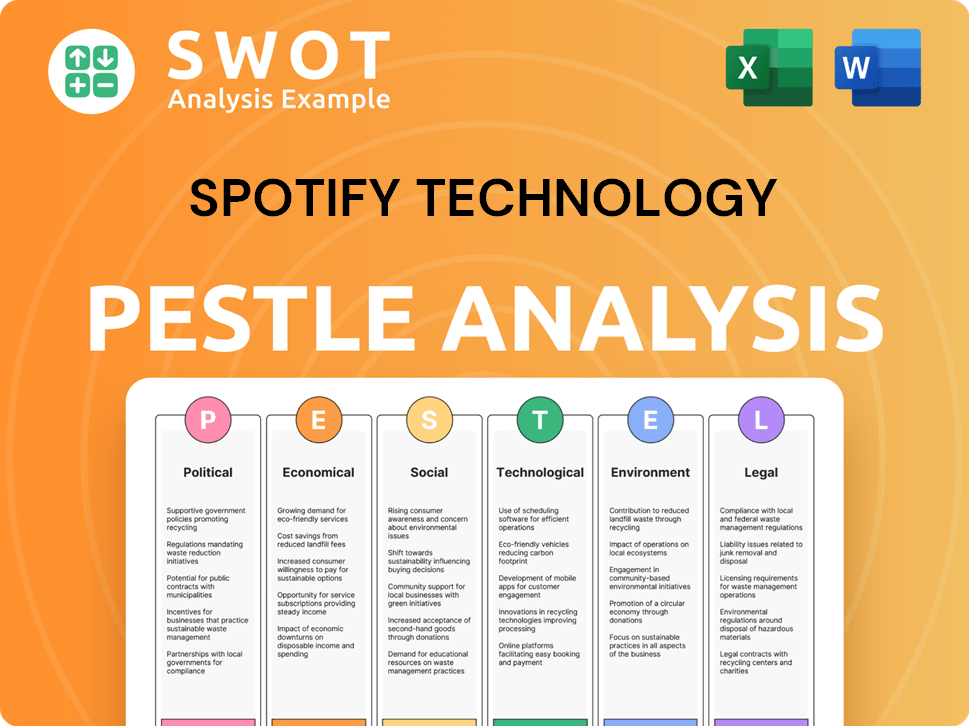
How Is Spotify Technology Positioned in the Market?
Spotify positions itself as the leading audio streaming and media services platform. It distinguishes itself through a vast and diverse content library, a highly personalized user experience, and a strong emphasis on community and discovery. The core message revolves around unlocking human creativity and connecting artists with fans.
The brand's visual identity, often characterized by its vibrant green and minimalist design, along with a dynamic and engaging tone of voice, reinforces its innovative and user-centric appeal. Spotify's Growth Strategy of Spotify Technology focuses on user engagement and content expansion.
Spotify's brand positioning is strengthened by its focus on innovation and personalization, with features like 'Discover Weekly' and 'Spotify Wrapped' central to its customer experience. The platform's commitment to providing a tailored listening experience builds a strong connection with its audience.
Spotify primarily targets young adults aged 18-34, who make up over 62% of its user base. The platform also shows increasing interest among older audiences, specifically those aged 35-54. This focus helps in refining the Spotify marketing strategy.
Spotify maintains a strong market leadership position, with a global market share of 32% in 2024. This market share indicates a positive brand perception and effective Spotify sales strategy.
Spotify continually expands into new content formats, including podcasts and audiobooks, to stay competitive. This expansion is a key part of its strategy to enhance user engagement strategies.
The platform enhances features such as the AI DJ and Group Sessions to improve user experience. These enhancements are part of the Spotify's user acquisition and customer retention strategies.
Spotify maintains consistency across all channels through personalized content delivery and a unified visual and auditory experience. It responds to competitive threats by continually innovating.
- Data-Driven Marketing: Spotify uses data to understand user preferences.
- Freemium Model: The freemium model is a key part of the Spotify business model.
- Partnerships: Spotify partners with artists to provide exclusive content.
- International Expansion: Spotify's international expansion strategy is ongoing.
Spotify Technology Business Model Canvas
- Complete 9-Block Business Model Canvas
- Effortlessly Communicate Your Business Strategy
- Investor-Ready BMC Format
- 100% Editable and Customizable
- Clear and Structured Layout
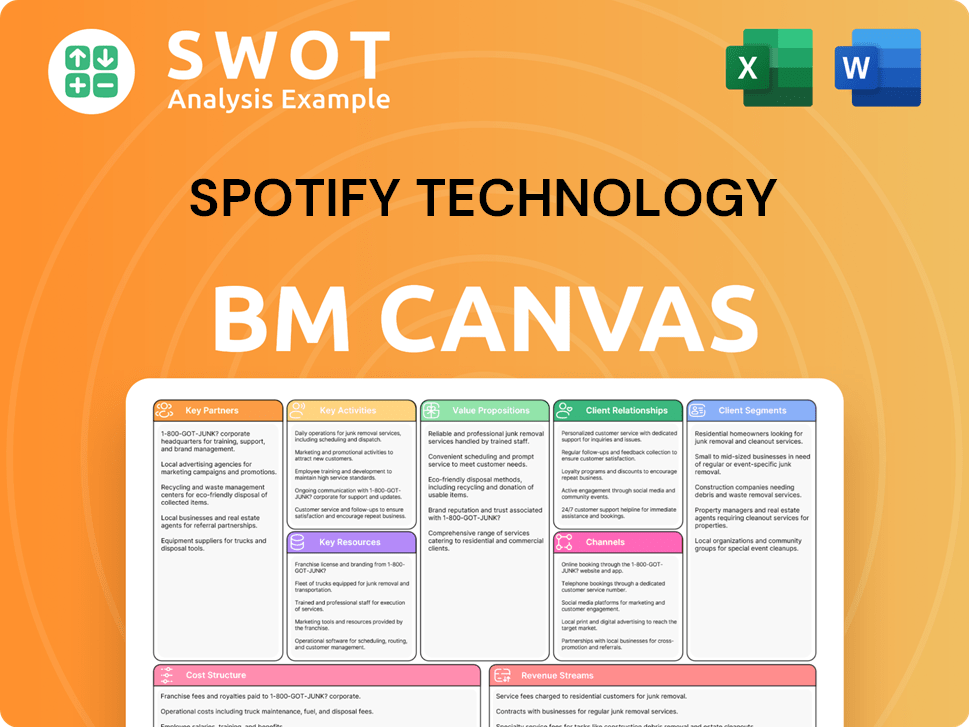
What Are Spotify Technology’s Most Notable Campaigns?
Understanding the key campaigns is crucial to grasping the Spotify sales strategy and Spotify marketing strategy. These campaigns directly influence user engagement, brand loyalty, and ultimately, revenue generation. A deep dive into successful initiatives reveals the core tactics behind its growth and market dominance.
These campaigns are designed to enhance Spotify user acquisition and retention by leveraging data-driven insights and strategic partnerships. By examining these campaigns, we can better understand the Spotify business model and the company's approach to navigating the competitive landscape. The effectiveness of these strategies is reflected in the company's continued expansion and influence in the music streaming industry.
One of the most impactful marketing initiatives is the annual 'Wrapped' campaign. This campaign provides personalized listening data to users, fostering a strong connection with the platform and encouraging social media sharing.
The primary objectives of the 'Wrapped' campaign are to deepen user engagement, boost brand loyalty, and generate widespread social media virality. This campaign aims to transform user data into shareable content, encouraging users to promote their unique listening summaries across various social media platforms.
The 'Wrapped' campaign cleverly combines user data with visually appealing, shareable content. It taps into the personal nature of music and identity, encouraging users to share their unique listening summaries across social media platforms. The campaign's design is user-centric, focusing on individual listening habits.
'Wrapped' is primarily an in-app experience with a strong push for sharing on social media platforms like Instagram, TikTok, and X/Twitter. The platform also utilizes artist and podcaster clips and editorial playlists to amplify the campaign. This multi-channel approach ensures broad reach and user engagement.
The 10th annual 'Wrapped' campaign in 2024 delivered double-digit year-over-year growth in user engagement across 184 markets. It has become a cultural phenomenon, driving significant conversations and reinforcing Spotify's cultural relevance. The campaign's success continues to be a significant driver of user engagement.
The success of 'Wrapped' stems from its deep personalization, which allows users to feel a unique connection to their listening data. The shareable nature of the content encourages organic growth and acts as a powerful FOMO (Fear Of Missing Out) driver for non-users. While the 2024 iteration, which teamed up with Google AI's NotebookLM for an AI-generated personalized podcast, received mixed reactions, its core success in driving engagement remains.
Another notable campaign involves strategic partnerships. For example, the collaboration with Google to offer Google Home Mini devices to new Premium subscribers in 2024. These collaborations boost brand visibility and contribute to subscriber growth.
In June 2024, the platform partnered with the fashion brand Acne Studios to curate music experiences and expand Acne Studios' 'Acne People' talent program. This blends fashion, music, and technology, enhancing the platform's brand appeal and attracting new audiences. These partnerships expand the platform's reach.
These collaborations leverage the partners' reach and credibility, enhancing the platform's brand appeal and attracting new audiences. These strategic alliances are integral to the platform's marketing strategy. These partnerships are key to its sustained growth.
The platform is focused on enhancing user experience through personalized features and curated content. This approach is central to retaining existing users and attracting new ones. This focus is a key component of the company's success.
The platform utilizes a data-driven marketing approach, analyzing user behavior and preferences to tailor its campaigns. This allows for more effective targeting and personalization. The use of data is a core element of its strategy.
The platform is constantly innovating, such as the integration of AI in its 'Wrapped' campaign, to stay relevant and engaging. This continuous innovation is crucial for sustaining its competitive edge. This constant evolution is a key factor.
For a deeper understanding of the company's origins and evolution, consider reading a Brief History of Spotify Technology. These campaigns are central to the platform's marketing efforts.
Spotify Technology Porter's Five Forces Analysis
- Covers All 5 Competitive Forces in Detail
- Structured for Consultants, Students, and Founders
- 100% Editable in Microsoft Word & Excel
- Instant Digital Download – Use Immediately
- Compatible with Mac & PC – Fully Unlocked
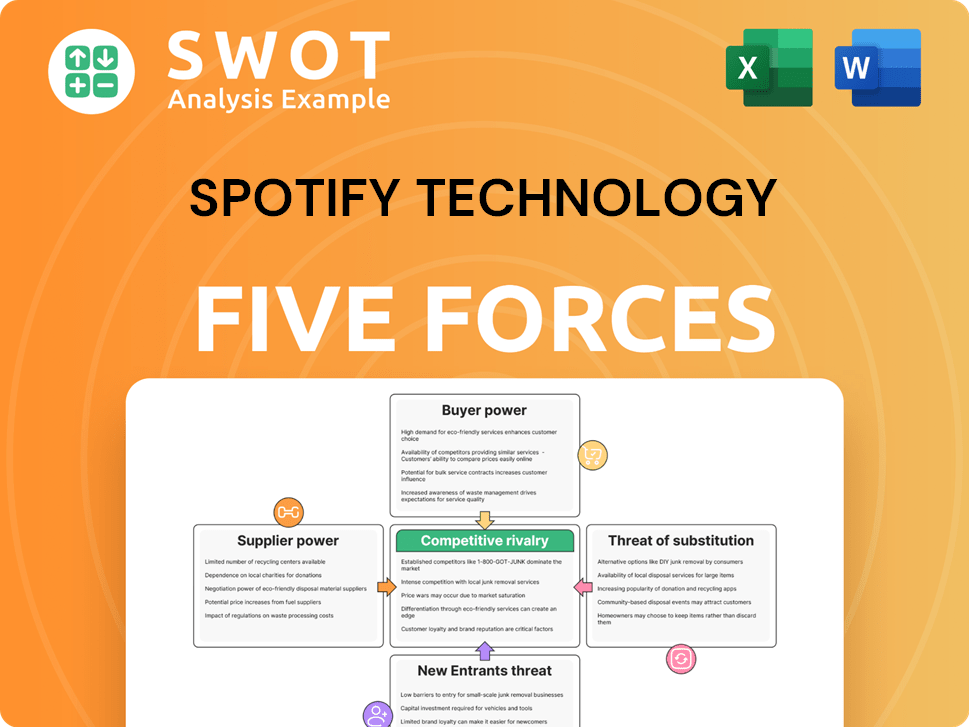
Related Blogs
- What are Mission Vision & Core Values of Spotify Technology Company?
- What is Competitive Landscape of Spotify Technology Company?
- What is Growth Strategy and Future Prospects of Spotify Technology Company?
- How Does Spotify Technology Company Work?
- What is Brief History of Spotify Technology Company?
- Who Owns Spotify Technology Company?
- What is Customer Demographics and Target Market of Spotify Technology Company?
Disclaimer
All information, articles, and product details provided on this website are for general informational and educational purposes only. We do not claim any ownership over, nor do we intend to infringe upon, any trademarks, copyrights, logos, brand names, or other intellectual property mentioned or depicted on this site. Such intellectual property remains the property of its respective owners, and any references here are made solely for identification or informational purposes, without implying any affiliation, endorsement, or partnership.
We make no representations or warranties, express or implied, regarding the accuracy, completeness, or suitability of any content or products presented. Nothing on this website should be construed as legal, tax, investment, financial, medical, or other professional advice. In addition, no part of this site—including articles or product references—constitutes a solicitation, recommendation, endorsement, advertisement, or offer to buy or sell any securities, franchises, or other financial instruments, particularly in jurisdictions where such activity would be unlawful.
All content is of a general nature and may not address the specific circumstances of any individual or entity. It is not a substitute for professional advice or services. Any actions you take based on the information provided here are strictly at your own risk. You accept full responsibility for any decisions or outcomes arising from your use of this website and agree to release us from any liability in connection with your use of, or reliance upon, the content or products found herein.